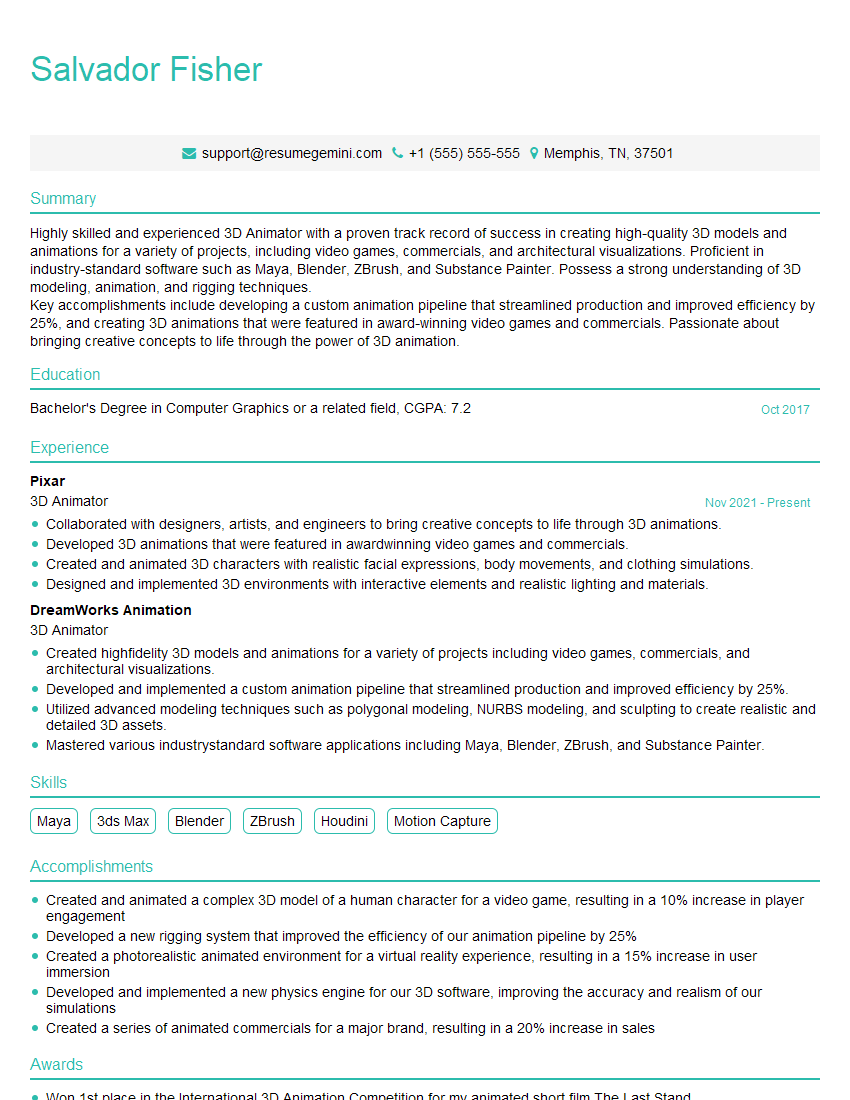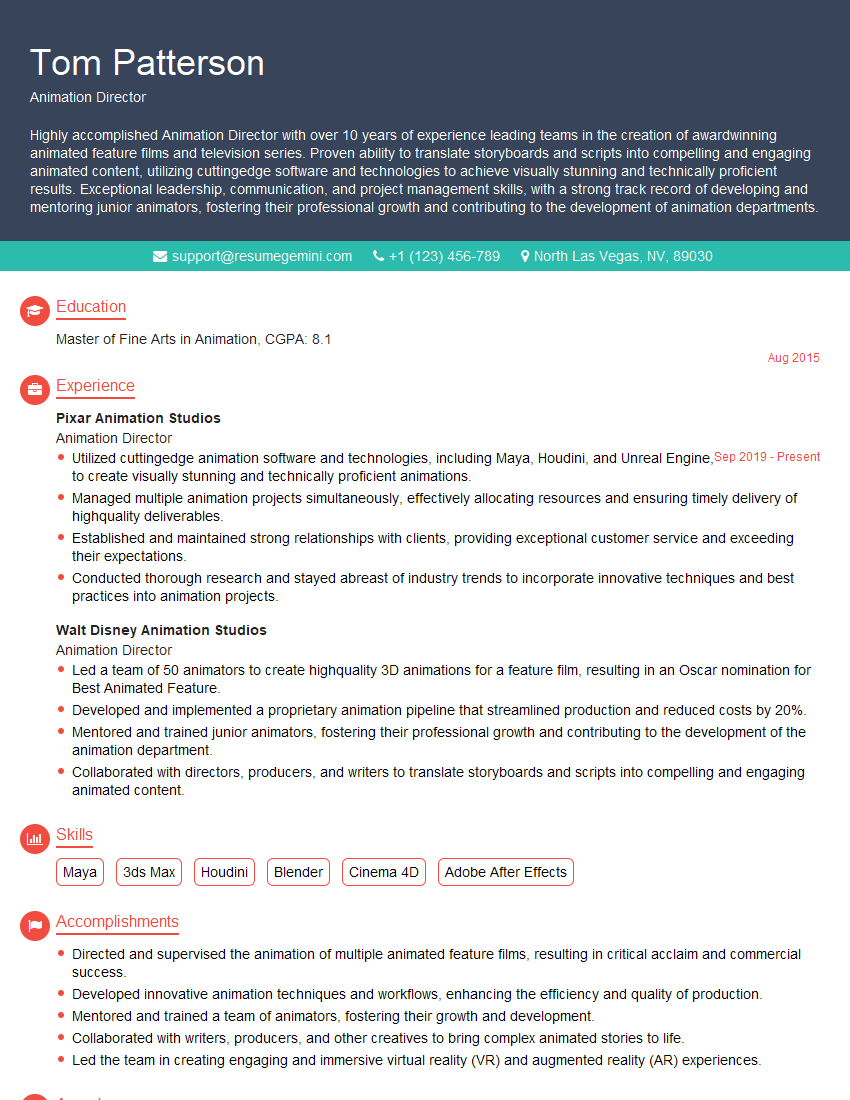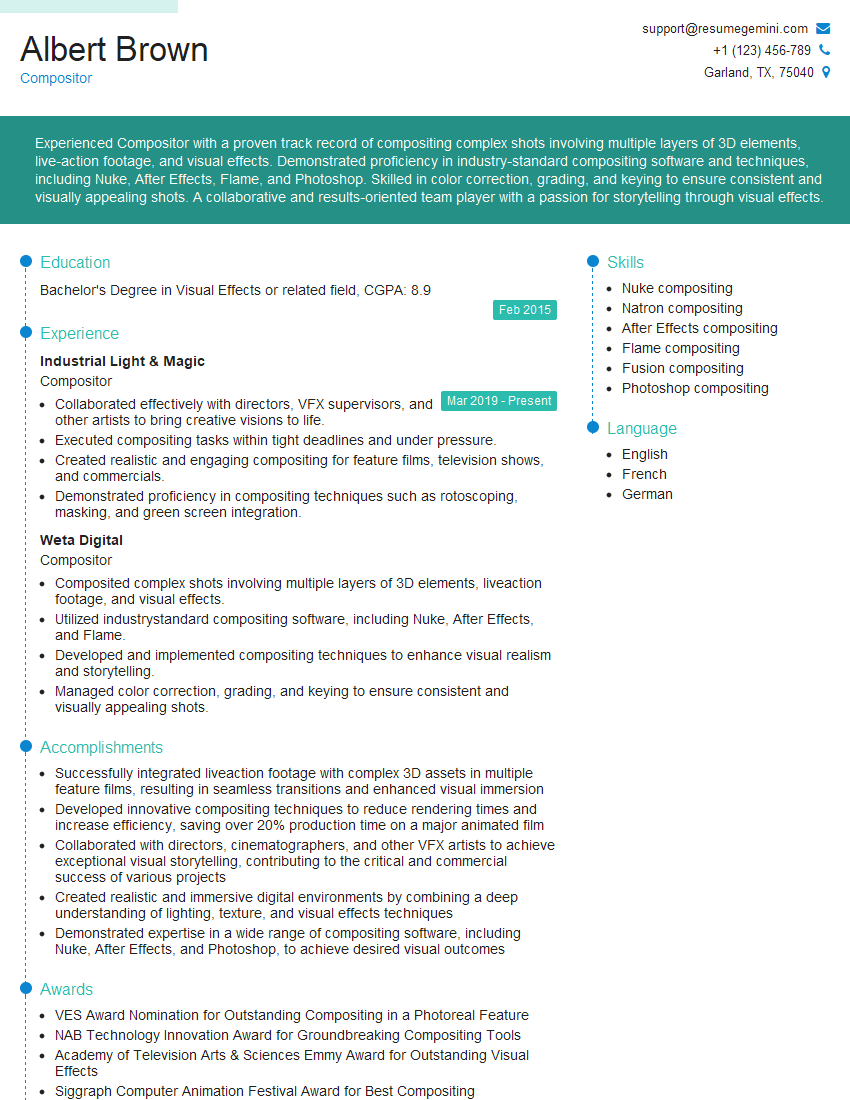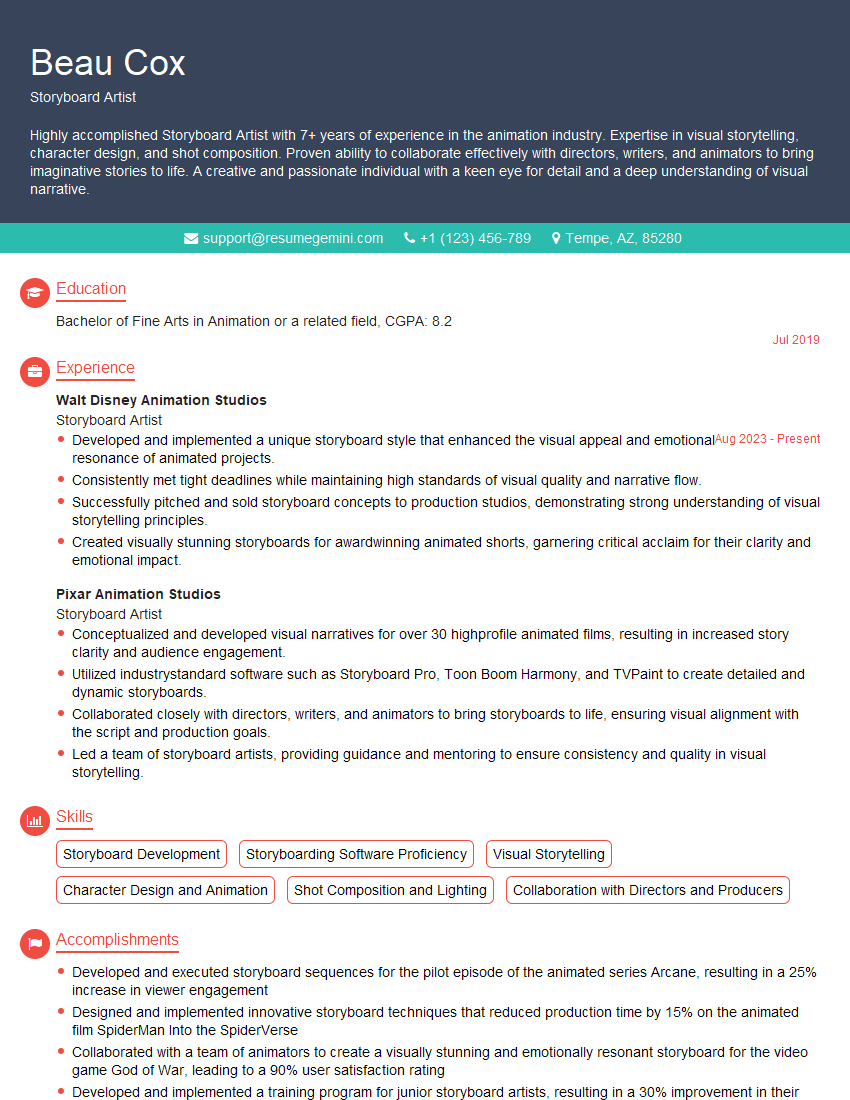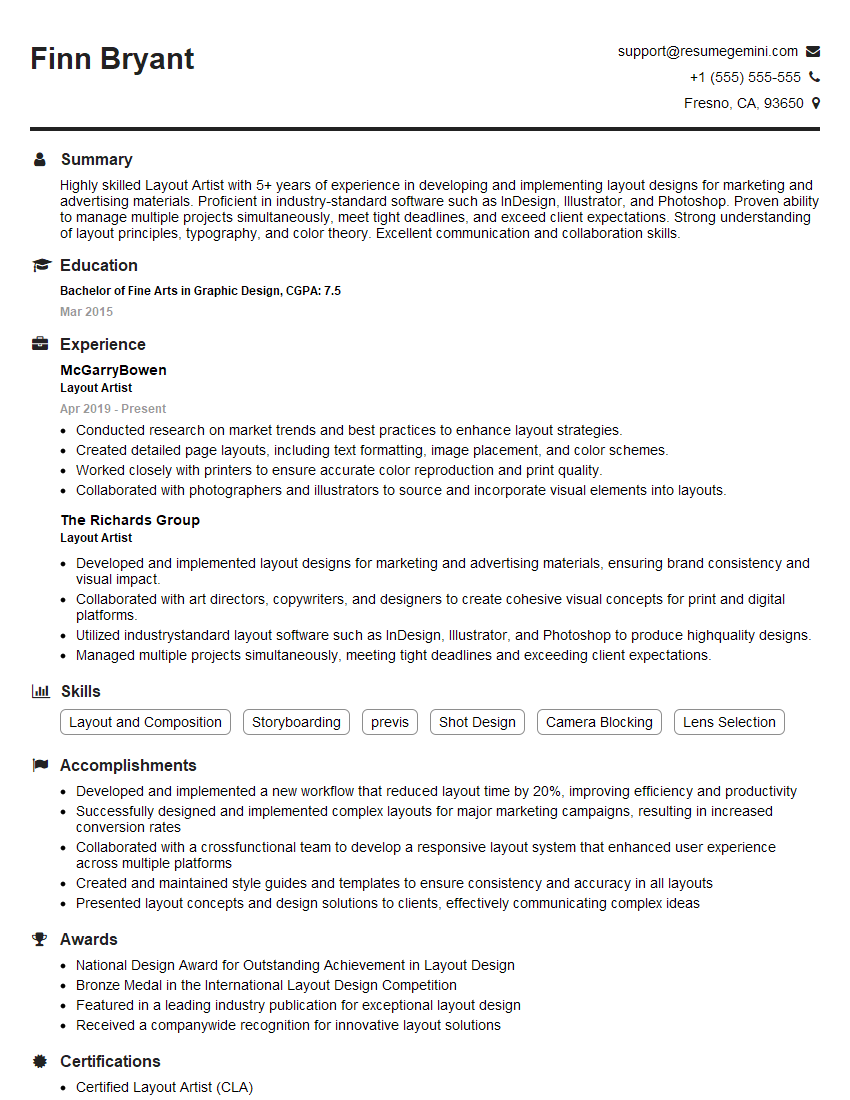Interviews are opportunities to demonstrate your expertise, and this guide is here to help you shine. Explore the essential Passion for Animation interview questions that employers frequently ask, paired with strategies for crafting responses that set you apart from the competition.
Questions Asked in Passion for Animation Interview
Q 1. Explain your animation workflow from concept to final product.
My animation workflow is a meticulous process, broken down into several key stages. It begins with concept development, where I collaborate with the team to solidify the narrative, character designs, and overall visual style. This often involves storyboarding, which helps visualize the sequence of events. Next comes pre-production, encompassing asset creation (models, textures, environments) and animatic creation (rough animation with placeholder audio). This allows for early feedback and adjustments before diving into the time-consuming animation phase. The animation phase itself is iterative, involving blocking (setting up the main poses), refinement (adding secondary animation, like subtle movements and expressions), and polishing (final tweaks for timing, spacing, and weight). Post-production includes rendering, compositing, and finally, the addition of sound effects and music. Throughout this entire process, constant review and feedback are crucial to ensure the final product aligns with the vision and meets the highest quality standards. For instance, on a recent project animating a playful squirrel, I started with simple sketches, moved to a detailed storyboard, and then progressed through the stages, focusing on realistic fur movement and expressive eyes to bring the character to life.
Q 2. Describe your experience with different animation software (e.g., Maya, Blender, After Effects).
I’m proficient in several industry-standard animation software packages. Maya is my primary tool for 3D character animation; I appreciate its powerful rigging and animation tools. I’ve also extensively used Blender, a fantastic open-source alternative, particularly beneficial for its robust modeling and rendering capabilities, perfect for quick prototyping and personal projects. For compositing and visual effects, After Effects is my go-to software. I utilize its layering and effects tools to add final touches to my animations, integrating elements like particle effects, color correction, and motion graphics. My experience with these programs allows me to adapt my workflow to different project needs and deadlines, selecting the most appropriate tool for the task at hand. For example, I used Blender’s sculpting tools to quickly create a creature design for a short film, then switched to Maya for the detailed rigging and animation.
Q 3. What are the key principles of animation?
The twelve principles of animation, established by Disney animators, are fundamental to creating believable and engaging animation. These principles guide the creation of fluid and expressive movement. They include: Squash and Stretch (giving objects flexibility), Anticipation (preparing for an action), Staging (clear presentation of the action), Straight Ahead Action and Pose to Pose (two different animation approaches), Follow Through and Overlapping Action (natural movement continuation), Slow In and Slow Out (realistic acceleration and deceleration), Arcs (natural movement paths), Secondary Action (supporting the main action), Timing (controlling the speed of actions), Exaggeration (emphasizing key movements), Solid Drawing (understanding form and volume), and Appeal (creating engaging characters). Understanding and applying these principles ensures that animations feel realistic, expressive, and engaging, regardless of the style.
Q 4. How do you approach animating realistic human movement?
Animating realistic human movement requires a deep understanding of anatomy, physics, and acting. I begin by studying reference material, including video footage of real people performing similar actions. I pay close attention to the subtleties of movement, like weight shift, muscle tension, and the interplay between different body parts. Rigging the character is crucial—a well-built rig allows for fluid and believable movement. I often use motion capture data as a base, but I always refine it manually to ensure the animation has personality and doesn’t feel stiff or robotic. I utilize techniques like posing and spacing to emphasize key moments, making the movement dynamic and visually compelling. For example, when animating a running character, I meticulously studied how the legs move, how the arms swing, and how the body rotates to create a natural and convincing representation.
Q 5. How do you handle feedback during the animation process?
Feedback is an integral part of the animation process. I actively solicit and incorporate feedback from directors, supervisors, and other team members throughout the project. I believe in creating a collaborative environment where open communication is encouraged. I typically hold regular reviews, presenting my work in progress and actively listening to the comments. I use feedback to identify areas for improvement, refine my animations, and ensure the final product meets the project’s goals. Constructive criticism is invaluable; it’s not about ego, but about creating the best possible animation. I strive to understand the rationale behind each piece of feedback and approach revisions with a solution-oriented mindset. For example, if feedback suggests a character’s movement lacks weight, I would focus on adjusting the timing and spacing to simulate gravity more convincingly.
Q 6. Discuss your experience with different animation styles (e.g., cel-shaded, realistic, cartoon).
I have experience working with a variety of animation styles. Cel-shaded animation, with its distinct outlines and flat colors, offers a stylized look, ideal for games or comics. I’ve used this technique to create vibrant and expressive characters. Realistic animation, on the other hand, demands a high level of detail and accuracy in modeling, rigging, and animation to create photorealistic results; my experience with motion capture data greatly aids this process. Cartoon animation allows for much greater freedom and exaggeration, focusing on humor and visual appeal. I adapt my approach to suit each style. The technical challenges differ greatly; realistic animation necessitates meticulous attention to detail, whereas a cartoon style might prioritize bold movements and expressive character design. For example, I recently worked on a project that seamlessly blended cel-shaded and realistic techniques, demanding a nuanced understanding of both styles.
Q 7. How do you manage your time effectively on animation projects?
Effective time management is crucial in animation. I begin by creating detailed shot breakdowns, estimating the time required for each task, and setting realistic deadlines. I utilize project management tools to track progress, identify potential bottlenecks, and stay organized. Prioritization is key; I tackle the most critical tasks first and break down large tasks into smaller, manageable chunks. I also maintain a consistent workflow, ensuring I’m always making progress. Regular communication with the team helps to identify and resolve potential delays proactively. Furthermore, I’m always mindful of my own energy levels; taking breaks and maintaining a healthy work-life balance is crucial for long-term productivity and avoids burnout. By incorporating these strategies, I’ve consistently managed to deliver high-quality work while meeting project deadlines.
Q 8. Describe your experience with rigging characters.
Rigging is the process of creating a skeletal structure for a 3D character model, allowing animators to manipulate its pose and movement. My experience encompasses a wide range of rigging techniques, from simple rigs for basic character animations to complex rigs for characters with intricate clothing and facial expressions. I’m proficient in various software packages, including Autodesk Maya and Blender. For example, I recently rigged a complex humanoid character for a short film, incorporating advanced features such as facial rigging with blendshapes for nuanced expressions and a robust IK/FK (Inverse Kinematics/Forward Kinematics) system for smooth and natural movement. This involved meticulous weight painting to ensure realistic deformation of the character’s skin and clothing. In another project, I developed a custom rig for a creature with unique anatomy, requiring a highly tailored approach to control its movements. I always prioritize creating rigs that are efficient, intuitive, and maintain a high degree of artistic control for the animators.
Q 9. How do you troubleshoot technical issues during animation?
Troubleshooting technical issues in animation is a crucial skill. My approach is systematic. First, I identify the problem precisely. Is it a rendering issue, a rigging problem, or a software glitch? Then, I isolate the problem by testing different components of the animation. For instance, if a character’s movement is jerky, I’d check the animation curves, the rig’s setup, and any potential collision issues. I utilize the software’s debugging tools effectively, examining logs and error messages to pinpoint the source. If the problem is software-related, I consult online resources, forums, and documentation, and sometimes reach out to colleagues for expertise. I meticulously document my troubleshooting steps, which helps in future problem-solving and prevents repeating the same mistakes. A recent example involved a rendering error that initially seemed mysterious. By systematically checking the scene files, I discovered a faulty texture map causing the error. Replacing the faulty file resolved the issue instantly.
Q 10. Explain your experience with motion capture data.
My experience with motion capture (MoCap) data involves processing, cleaning, and retargeting it to 3D character rigs. I’m familiar with different MoCap data formats and workflows. I’ve used software like Autodesk MotionBuilder to import, edit, and clean MoCap data, removing noise and outliers to ensure smooth and believable animation. Retargeting, which is the process of transferring MoCap data from a source model to a different character model, requires careful consideration of scale, proportions, and bone structures. I’ve worked on projects requiring significant retargeting adjustments, particularly when the MoCap data was captured from a human actor and applied to a creature with vastly different anatomy. I also understand the limitations of MoCap data and often use it as a base, refining the animation manually to add more nuanced performance and subtle details. For example, on a recent project featuring a horse character, I used MoCap data for the horse’s primary locomotion but then meticulously hand-animated the facial expressions and subtle body language to enhance the character’s expressiveness.
Q 11. What are some common challenges in animation and how do you overcome them?
Animation presents various challenges. One common problem is maintaining consistency in style and quality across a large project. This can be overcome through detailed style guides, regular team reviews, and consistent use of reference material. Another challenge is meeting tight deadlines while maintaining creative integrity. Effective project management and time allocation are key here; breaking down tasks into manageable chunks and prioritizing effectively are crucial. Technical issues, as discussed earlier, are always a possibility; proactive problem-solving and robust troubleshooting skills are vital. Finally, achieving believable and compelling character performance is a constant challenge. Careful consideration of character personality, motivations, and relationships with other characters is essential, alongside thorough research and study of human and animal movement.
Q 12. Describe your experience with creating storyboards.
Storyboard creation is a critical early stage in animation, laying the foundation for the visual narrative. My experience includes creating storyboards for various projects, ranging from short animated films to commercials. I’m proficient in both traditional hand-drawn and digital methods. I understand the importance of clear panel layouts, dynamic composition, and concise visual storytelling. A strong storyboard clearly communicates the action, camera angles, character expressions, and overall pacing of the scene. I always prioritize collaboration with the director and other members of the team to ensure the storyboards effectively translate the project’s vision. In a recent project, my storyboards were instrumental in clarifying complex action sequences, making the subsequent animation process significantly smoother and more efficient. For each scene, I started with rough sketches to establish the core action and then refined these sketches to produce detailed and polished storyboards including notes regarding character expressions, sound effects and camera angles.
Q 13. How do you collaborate effectively with other artists on a team?
Effective collaboration is paramount in animation. I strive to maintain open communication, actively participating in team meetings, providing constructive feedback, and clearly expressing my ideas and concerns. I believe in active listening and respecting diverse perspectives. I value shared goals and utilize collaborative tools, such as online project management software, to ensure everyone is aligned and informed. Regular check-ins with team members help identify potential problems early on and prevent delays. I also understand the importance of delegation and teamwork, recognizing each team member’s strengths and ensuring responsibilities are appropriately distributed. This collaborative spirit led to the successful completion of several challenging projects where diverse skills and perspectives were crucial to achieving a high-quality final product.
Q 14. How do you maintain the consistency of animation style throughout a project?
Maintaining consistent animation style across a project demands meticulous planning and execution. I use detailed style guides, created collaboratively with the team, to define key aspects like character design, movement, color palettes, and camera angles. This guide serves as a shared reference throughout the project. Regular style reviews are conducted to ensure everyone adheres to the established guidelines. Consistent use of reference materials and maintaining a centralized resource library of approved assets further contributes to consistency. Regular feedback sessions, where animators can review each other’s work, help in spotting deviations from the established style early and resolving inconsistencies before they become problematic. A strong pipeline and clear communication throughout the team are essential for upholding style consistency, ensuring a unified and cohesive final product.
Q 15. How familiar are you with industry standard file formats?
Industry-standard file formats are crucial for seamless collaboration and workflow in animation. My familiarity encompasses a wide range, including those for 2D and 3D animation. For 2D, I’m proficient with formats like PSD (Photoshop Document) for layered artwork, AI (Adobe Illustrator) for vector graphics, and SVG (Scalable Vector Graphics) for web-based animation. In 3D, I’m adept at using FBX (Filmbox), a versatile format supporting various 3D software, OBJ (Wavefront OBJ) for geometry data, and Alembic (.abc) for complex cache data, especially useful for simulations and effects. I also understand the importance of using appropriate image sequences like PNG for transparency and JPEG for compression, depending on the project’s needs. Choosing the right format is a key consideration—it affects file size, compatibility, and data integrity throughout the pipeline.
Career Expert Tips:
- Ace those interviews! Prepare effectively by reviewing the Top 50 Most Common Interview Questions on ResumeGemini.
- Navigate your job search with confidence! Explore a wide range of Career Tips on ResumeGemini. Learn about common challenges and recommendations to overcome them.
- Craft the perfect resume! Master the Art of Resume Writing with ResumeGemini’s guide. Showcase your unique qualifications and achievements effectively.
- Don’t miss out on holiday savings! Build your dream resume with ResumeGemini’s ATS optimized templates.
Q 16. What are your strengths and weaknesses as an animator?
My greatest strength lies in my ability to craft believable and expressive characters. I combine a strong understanding of anatomy and acting principles with a keen eye for detail. For instance, I recently worked on a project where I had to animate a character experiencing intense grief. I meticulously studied real-life footage of human behavior in such situations to realistically portray the character’s emotional turmoil. My weakness is sometimes being too perfectionistic, leading to longer-than-anticipated work hours. I’m actively working on improving my time management skills and prioritizing tasks to become more efficient.
Q 17. Describe your experience with different rendering techniques.
My experience with rendering techniques spans both raster-based and ray-tracing methods. I’m highly proficient in using scanline renderers, which are efficient and suitable for real-time applications. I also have experience with path tracing and photon mapping, powerful techniques for creating photorealistic imagery. My understanding encompasses the use of different shaders to achieve specific surface properties—from metallic reflections to diffuse scattering. I’ve also worked with Global Illumination techniques to simulate realistic lighting interactions. For example, I used path tracing to create highly realistic lighting in a forest scene and scanline rendering for a real-time animated short. The choice of rendering method heavily depends on project requirements, deadline, and desired visual quality.
Q 18. How do you balance artistic vision with technical constraints?
Balancing artistic vision with technical constraints is a fundamental aspect of animation. It often requires creative problem-solving. For instance, if I envision a highly complex character design with intricate details, I might need to adjust it based on the project’s polygon budget to ensure smooth playback. This involves finding smart ways to simplify geometry without compromising the character’s essence. A similar challenge arises when working with limited rendering power. I might need to adapt my lighting or visual effects to work within those boundaries, optimizing the scenes for the available resources without sacrificing the overall artistic impact. It’s about finding a sweet spot where both vision and practicality coexist.
Q 19. Explain your process for creating believable character expressions.
Creating believable character expressions is a process grounded in understanding human anatomy and emotion. I start by studying references—photographs, video recordings, even observing people in real life. This helps me understand how muscles move and how they affect facial features during different emotions. I then translate these observations into key poses and animation, using techniques like exaggeration and secondary animation to enhance the impact. For example, subtle eyebrow movements and eye blinks can add layers of complexity to an expression. I meticulously plan the timing and spacing of these movements to make sure the emotions feel natural and authentic, avoiding stiff or unrealistic results.
Q 20. Describe your understanding of animation physics and mechanics.
A deep understanding of animation physics and mechanics is essential for creating realistic and believable movement. I leverage principles like mass, weight, and inertia to determine how characters and objects behave in the animation. For instance, a heavy object will fall more slowly than a light one, and its movement will exhibit more inertia. I apply principles of Newtonian physics to simulate realistic interactions, such as collisions and momentum transfer. Understanding torque and angular momentum allows me to animate rotational movements with accuracy. These principles are applied to both character animation, like the realistic swing of a character’s limbs, and object animation, like the accurate bounce of a ball. The goal is to create movement that feels natural, grounded, and visually compelling.
Q 21. How do you stay current with the latest animation techniques and trends?
Staying current in animation involves continuous learning. I actively follow industry blogs, publications, and online communities like dedicated forums and social media groups. Attending industry conferences, workshops, and online courses keeps me updated on the latest software, techniques, and technological advancements. I also regularly watch and analyze high-quality animated films and shows to learn from masters and stay inspired. Furthermore, experimenting with new tools and techniques within personal projects allows me to apply theoretical knowledge and develop practical skills. This approach keeps my knowledge fresh and my skills sharp, ensuring I can adapt to the ever-evolving landscape of animation.
Q 22. What is your preferred animation software and why?
My preferred animation software is a combination of Toon Boom Harmony and Adobe After Effects. This isn’t a singular ‘best’ choice, as different software excels in different areas, but this pairing covers my needs exceptionally well. Toon Boom Harmony is my primary tool for 2D animation; its streamlined vector-based workflow allows for efficient creation and modification of characters and backgrounds, crucial for managing complex projects. Its features for rigging, animation, and compositing are highly intuitive and powerful. Adobe After Effects, on the other hand, is invaluable for compositing, visual effects, and motion graphics. I often use After Effects to add post-production polish, integrate 3D elements, and enhance the overall visual impact of my animations. The two work seamlessly together in my pipeline.
Q 23. Discuss your portfolio and highlight your most significant accomplishments.
My portfolio showcases a range of projects, from short animated films to character design and animation for commercial work. I’m particularly proud of my short film, “Ephemeral Echoes.” It involved intricate character animation, demanding background design, and a challenging narrative structure. The animation style was unique, blending traditional 2D techniques with subtle digital effects. This project required extensive planning, storyboarding, and meticulous execution. The positive critical reception, including an award at the local film festival, validated the months of hard work put into achieving a high level of artistic and technical polish. Another significant accomplishment was my work on the animated commercial for “Sparkling Springs” bottled water. This project required working within strict brand guidelines while creating engaging animation that reflected the product’s refreshing quality. I successfully integrated 3D elements to create a dynamic visual experience, showcasing my ability to manage different animation styles within a commercial deadline.
Q 24. How do you handle criticism of your work?
Criticism is vital to growth. I approach it constructively, viewing it not as a personal attack but as an opportunity to refine my work. My process involves actively listening to the feedback, considering the source’s expertise, and carefully evaluating whether the points raised are valid and applicable. I then separate constructive criticism from subjective opinions. For example, if feedback points out inconsistencies in animation timing, I take that seriously and revise my work accordingly. However, if a critique is purely subjective, such as a preference for a different color palette, I may choose to reflect upon it, but it won’t necessarily dictate changes if I’m confident in my original artistic choices. Documenting feedback and integrating the valid points helps me evolve my skills and approach.
Q 25. How do you deal with tight deadlines and pressure?
Meeting tight deadlines under pressure is a common challenge in the animation industry. My strategy involves meticulous planning and efficient time management. I begin by breaking down complex projects into smaller, manageable tasks. This task-based approach allows for easier tracking of progress and identification of potential bottlenecks. I prioritize essential tasks and build in buffer time to account for unforeseen delays. Effective communication with clients and collaborators is key; this prevents misunderstandings and ensures that everyone is on the same page. Using project management software helps me stay organized and provides a clear overview of the project’s timeline. In high-pressure situations, I focus on maintaining a calm, composed demeanor and remain flexible to adapt to any changes that may arise. Sometimes, prioritizing quality in certain areas while streamlining less crucial elements is a necessity for meeting tight deadlines.
Q 26. Describe your experience with different types of cameras in animation.
My experience encompasses various camera techniques in animation, mirroring those of live-action filmmaking. I’m proficient in using different camera movements to enhance storytelling and create dynamic visuals. For instance, a slow dolly zoom can emphasize a character’s emotional state, while quick cuts can create a sense of urgency. Understanding focal length is also critical: wide shots establish setting, medium shots focus on character interactions, and close-ups convey emotion through facial expressions. I leverage camera angles – high angles can make characters appear vulnerable, while low angles can make them seem powerful. In 2D animation software, I can simulate these movements by manipulating the camera’s position and focal length within the software’s interface, much like a traditional camera operator. Understanding the impact of different camera choices and employing them purposefully significantly elevates the storytelling potential of my animations.
Q 27. What is your approach to creating convincing character arcs?
Creating believable character arcs relies on a strong understanding of narrative structure and character development. I begin by defining clear character goals and motivations. These drive the character’s actions and decisions throughout the story. I also explore the character’s internal conflicts and external challenges, which lead to significant changes in their personality or perspective. This transformation should feel organic and believable. For example, a character initially driven by selfishness might, through a series of events, evolve to become more empathetic and selfless. This arc is achieved by crafting a series of events which challenge the character’s initial beliefs and push them towards personal growth. I use storyboarding and character sketches to visualize the transformation, outlining key emotional shifts and changes in behavior to ensure the character’s evolution feels natural and consistent with their initial personality.
Q 28. Describe your experience with lip-sync animation.
Lip-sync animation is a meticulous process requiring a deep understanding of phonetics and facial expressions. I begin by recording the dialogue, then carefully analyze the audio waveform to identify individual phonemes (speech sounds). Next, I use these audio cues to guide the character’s mouth movements. There’s no one-size-fits-all; each phoneme requires specific lip and mouth shapes. Software tools can assist in this process, but manual adjustments are often necessary to ensure accuracy and naturalness. For instance, the ‘mouth shape’ for the vowel ‘a’ is different from the shape for ‘i,’ and these subtle variations must be reflected in the animation. I aim to go beyond simply matching the mouth movements to the audio. I focus on creating realistic facial expressions that reflect the character’s emotions and enhance the overall performance. This ensures that the animation is engaging and emotionally resonant for the audience, surpassing mere mechanical lip-sync to bring the performance to life.
Key Topics to Learn for Your Passion for Animation Interview
- Animation Principles: Understanding and applying the 12 principles of animation (squash and stretch, anticipation, staging, etc.) in various animation styles.
- Software Proficiency: Demonstrating practical experience with industry-standard software like Maya, Blender, After Effects, or similar. Be prepared to discuss your workflow and project examples.
- Storytelling and Character Development: Articulating how you use animation to convey emotion, narrative, and character arcs. Showcase your understanding of character design and acting.
- Workflow and Pipeline: Explain your understanding of the animation production pipeline, from concept to final render. This includes asset creation, rigging, animation, and compositing.
- Technical Skills: Demonstrate your understanding of keyframing, timing, spacing, and easing techniques. Be prepared to discuss your approach to problem-solving within the animation process.
- Style and Aesthetics: Discuss your familiarity with different animation styles (e.g., 2D, 3D, stop-motion) and your ability to adapt your technique accordingly. Show your artistic influences and style preferences.
- Collaboration and Communication: Explain your experience working in teams and how you effectively communicate your ideas and receive feedback.
Next Steps
Mastering the art of animation opens doors to exciting and fulfilling careers in film, games, advertising, and beyond. A strong portfolio is essential, but a well-crafted resume is your first impression. An ATS-friendly resume maximizes your chances of getting your application noticed by recruiters. To build a truly professional and impactful resume, leverage the power of ResumeGemini. ResumeGemini provides a user-friendly platform and helpful tools to create standout resumes. Examples of resumes tailored to the animation industry are available within the ResumeGemini platform to guide you. Take the next step in your animation career journey today.
Explore more articles
Users Rating of Our Blogs
Share Your Experience
We value your feedback! Please rate our content and share your thoughts (optional).
What Readers Say About Our Blog
Hello,
We found issues with your domain’s email setup that may be sending your messages to spam or blocking them completely. InboxShield Mini shows you how to fix it in minutes — no tech skills required.
Scan your domain now for details: https://inboxshield-mini.com/
— Adam @ InboxShield Mini
Reply STOP to unsubscribe
Hi, are you owner of interviewgemini.com? What if I told you I could help you find extra time in your schedule, reconnect with leads you didn’t even realize you missed, and bring in more “I want to work with you” conversations, without increasing your ad spend or hiring a full-time employee?
All with a flexible, budget-friendly service that could easily pay for itself. Sounds good?
Would it be nice to jump on a quick 10-minute call so I can show you exactly how we make this work?
Best,
Hapei
Marketing Director
Hey, I know you’re the owner of interviewgemini.com. I’ll be quick.
Fundraising for your business is tough and time-consuming. We make it easier by guaranteeing two private investor meetings each month, for six months. No demos, no pitch events – just direct introductions to active investors matched to your startup.
If youR17;re raising, this could help you build real momentum. Want me to send more info?
Hi, I represent an SEO company that specialises in getting you AI citations and higher rankings on Google. I’d like to offer you a 100% free SEO audit for your website. Would you be interested?
Hi, I represent an SEO company that specialises in getting you AI citations and higher rankings on Google. I’d like to offer you a 100% free SEO audit for your website. Would you be interested?
good
